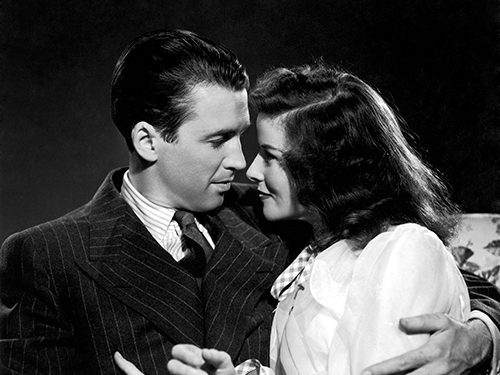
George Kittredge: You’re like some marvelous, distant, well... queen, I guess. You’re so cool and fine and always so much your own. There’s a kind of beautiful purity about you, Tracy, like... like a statue.
Tracy Lord: George...
Oh, it’s grand, Tracy. It’s what everybody feels about you. It’s what I first worshipped you for from afar.
I don’t want to be worshipped. I want to be loved.
“Tracy does look rather like a statue, as both Dex and her father accuse her of being. Only when she’s showing warmth and vulnerability, such as during the ineffably romantic garden-and-pool tryst with Mike that forms the climax of the movie, does Cukor move in for close-ups that make Hepburn flesh and blood once more. That midnight flirtation is also the apex of Joseph Ruttenberg’s cinematography, with night that really looks like night, and Stewart and Hepburn so alluring that the audience falls for them both at once. [...]
The Philadelphia Story is a wordy film, but Cukor’s direction of stars was always easy and natural. He follows the flow of Hepburn’s impossibly slim, tall body moving around rooms and lawns that Tracy has known all her life, and the rattle of all that dialogue flows right along with her. Then, too, Cukor knows how to keep still and give his audience the joy of picking up on the actors’ business. This is especially evident in the scenes where Mike and Liz, newly arrived at the Lords’ labyrinth of a mansion, pick up objects and put them down again and again, dumbfounded at a life that involves so much bric-a-brac. Later, as Mike walks through the room where the wedding presents are displayed (it’s Tracy’s second wedding, but she has received enough housewares to supply the Waldorf-Astoria), he picks up a spoon – probably not to pocket it, but we do see the thought cross his face. And Cukor’s camera moves as though on tiptoe to show that the butler has silently entered to smother such thoughts with the power of his glare. [...]
Mankiewicz attended the play [by Philip Barry] and made careful note of where the laughs were; Donald Ogden Stewart thanked him but wisely decided this was no way to compose a screenplay. Instead, he gracefully opened up the play’s two sets of sitting room and porch, adding other sites that emphasize the Lords’ wealth, such as the stables, located at such a distance that Tracy and Dinah take a limo to get there. Stewart (reportedly with help from an uncredited Waldo Salt) also added dialogue that at times out-Barryed Barry, while keeping the play’s best lines, such as Mike’s remark, as he sprawls in a lawn chair, that “the prettiest sight in this fine, pretty world is the privileged class enjoying its privileges.”
Farran Smith Nehme1
- 1Farran Smith Nehme, “The Philadelphia Story: A Fine, Pretty World,” The Criterion Collection, November 2017.

